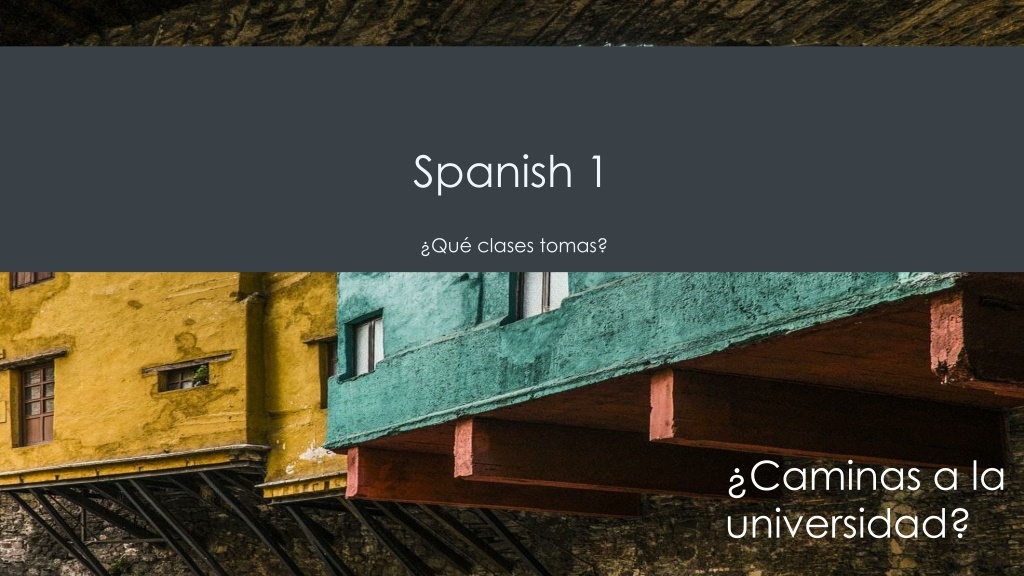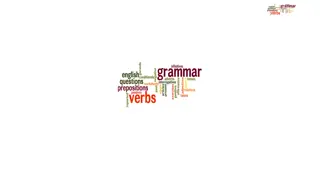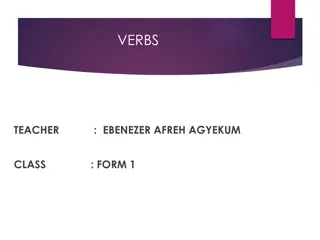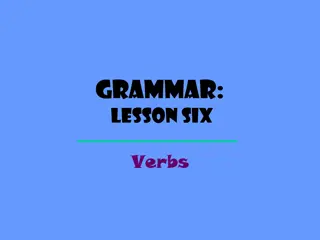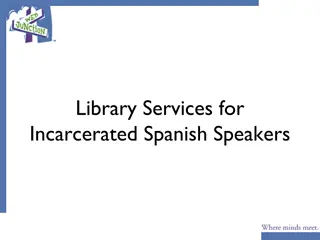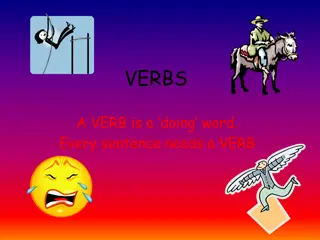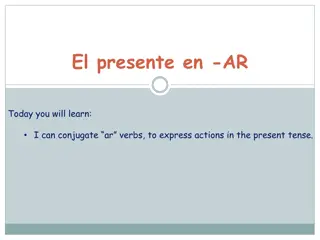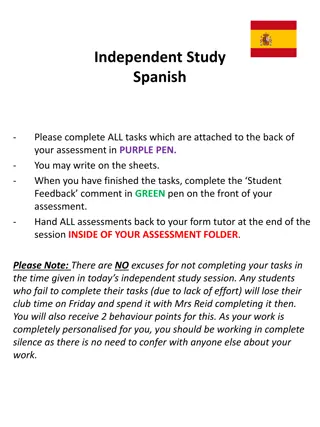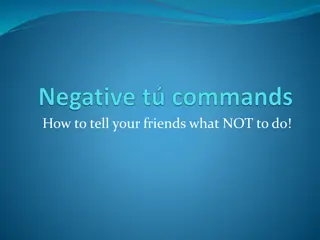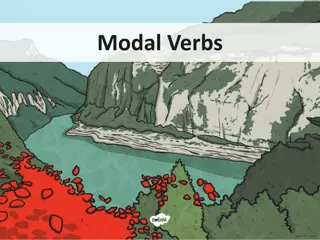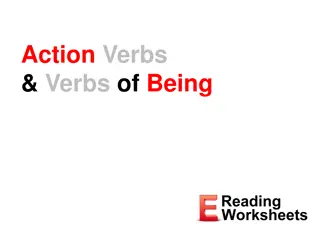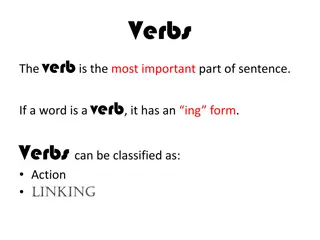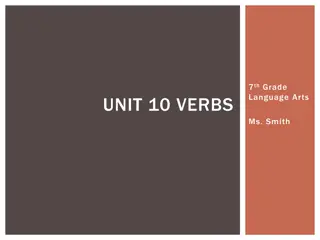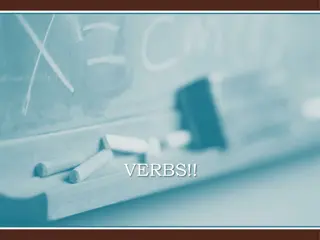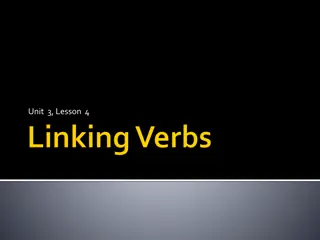Spanish 1 - Learning to Conjugate -ar Verbs
In this lesson, you will learn to conjugate -ar verbs in Spanish. The content covers identifying correct verb conjugations, answering questions using -ar verbs, and recognizing subjects based on verb conjugation. You will also practice with a list of common -ar verbs and learn the conjugation patterns for regular -ar verbs in the present tense. Get ready to enhance your Spanish language skills!
Download Presentation

Please find below an Image/Link to download the presentation.
The content on the website is provided AS IS for your information and personal use only. It may not be sold, licensed, or shared on other websites without obtaining consent from the author. Download presentation by click this link. If you encounter any issues during the download, it is possible that the publisher has removed the file from their server.
E N D
Presentation Transcript
Spanish 1 Qu clases tomas? Caminas a la universidad?
Learning Outcomes: Caminas a la universidad? 3.3.1: Identify the correct conjugations of verbs ending in ar. 3.3.2: Answer questions using -ar verbs. 3.3.3: Recognize the subject of a sentence (personal pronoun) based on verb conjugation (with -ar verbs).
Introduction to Caminas a la universidad? After learning about infinitive verbs, we are going to practice their conjugations. It may seem daunting at first, but remember: once you ve learned the pattern, it s just a matter of substitution.
Actividad de calentamiento 1 Recuerdas algunos verbos en infinitivo? Mira las im genes y trata de mencionar cada acci n usando verbos en su forma base. Hablar - Cantar Caminar
List of some -ar verbs ense ar (to teach) escuchar (to listen to) esquiar (to ski) estudiar (to study) ganar (to win) hablar (to talk) llamar (to call) llegar (to arrive) mandar (to send) mirar (to look at) ayudar (to help) bailar (to dance) buscar (to look for) caminar (to walk) cantar (to sing) cocinar (to cook) comprar (to buy) descansar (to rest) desear (to wish) nadar (to swim) necesitar (to need) practicar (to practice) preguntar (to ask) regresar (to return) tomar (to take) trabajar (to work) usar (to use) viajar (to travel)
Gramtica: Verbos regulares con -ar The verbs in the list on the previous slide are in their infinitive form. That s why the English translation usually starts with to (to help, to dance, etc.). All Spanish infinitives end in the letter r, and the three regular conjugation patterns are classified into -ar, -er, and -ir verbs. We ll learn about -er and -ir verbs in the next chapter. For now, let s look at the -ar verbs.
Gramtica: Verbos regulares con ar (cont.) Regular verbs ending in AR are conjugated in the present tense by removing the -AR infinitive ending and adding one of the following personal endings: Regular -ar Verbs Singular Plural First (yo) -o (nosotros) -amos Second (t ) -as (vosotros) - is * Third ( l / ella / usted) -a (ellos / ellas / ustedes) -an * Note: This second-person plural form (vosotros) is only used in the variety of Spanish used in Spain. In other Spanish dialects the third person plural form (ustedes) is used in both formal and informal plural direct-address situations.
Ejercicio Fill in the blank with the correct form of the verb. 1. Yo _____ (escuchar) m sica en las ma anas. 2. Ellas _____ (caminar) en la monta a. 3. Nosotros _____ (trabajar) por la noche. 4. Cuando est s en la residencia estudiantil, _____ (bailar)? 5. Mi hermana _____ (viajar) a Europa en dos semanas. 6. Vosotros _____ (comprar) nueva ropa para el verano.
Basic sentence structure: statements The basic structure of simple sentences in Spanish is the same as in English: subject verb object. Since the verb will be conjugated differently according to the different subjects, the verb ending will often make it perfectly clear who is doing the action and you can leave the subject off unless you want to clarify or emphasize who is doing the action. Estudiamos el espa ol. (We study Spanish.) La profesora explica la gram tica. (The professor explains the grammar.)
Basic sentence structure: yes-no questions Yes-no questions are also quite simple in Spanish, and there are two ways of expressing them: either they have the same word order as a simple sentence and are spoken with a rising intonation instead of falling, or the verb and subject are reversed (verb subject object). Just be sure to put the upside-down question mark at the beginning and the upside-right question mark at the end of each question. Also note that Spanish does NOT use an auxiliary or helping verb like English (do/does). Estudiamos el espa ol? (Do we study / are we studying Spanish?) Explica la profesora la gram tica? (Does the professor explain the grammar?)
Basic sentence structure: negation Answering affirmatively is easy, you just say s (yes) and state your answer. To make a negative sentence, just put the word no before the verb (subject no verb object). The Spanish word no means both no and not . And remember that Spanish does NOT use the auxiliary or helping verb (do/does). No estudiamos el franc s. (We do not study French.) La profesora no explica la tecnolog a. (The professor doesn t explain the technology.) No, los estudiantes no escuchan m sica en la clase. (No, the students do not listen to music in class.)
Modal verbs Some verbs can have another verb as their object; these are called modal verbs. The same person needs to be doing both actions, and the second verb is *not* conjugated. Necesito ir al ba o. (I need to go to the bathroom.) Deseo estudiar un idioma de cada continente. (I want to study one language from each continent.)
Actividad: Frases Instrucciones: Given the following subject, verb, and noun, create a sentence. Ejemplo: ella/ comprar/ un cuaderno Ella compra un cuaderno. La profesora/ ense ar/ la clase Ana/ usar/ la computadora Yo/ buscar/ un libro de matem ticas Juan y Marta/ esquiar/ en la monta a T / trabajar/ en la cafeter a? Alicia/ estudiar/ biolog a en el colegio Mi mam / cocinar/ huevos Nosotros/ necesitar/ ir a la biblioteca Ellos/ escuchar/ m sica T / caminar/ a la cafeter a
Practice Question 1 En el invierno, C rmen no _____ en el oc ano. A. nado B. nadar C. nadamos D. nada
Practice Question 2 Nosotros _____ de Espa a en tres d as. A. regreso B. regresan C. regresamos D. regres is
Practice Question 3 Give negative answer for the question: En esta clase estudias franc s? A. S , en esta clase estudiamos franc s. B. En esta clase s estudiamos franc s. C. En esta clase estudiamos alem n. D. No, en esta clase no estudiamos franc s.
Quick Review How are ar verbs conjugated? What is the basic sentence structure in Spanish? What words can you use in Spanish to answer questions?
